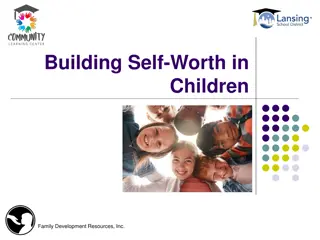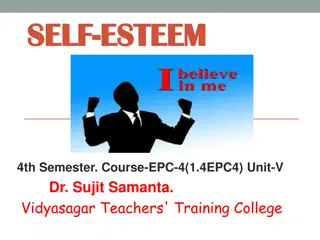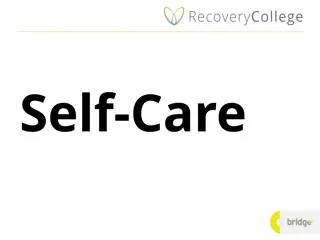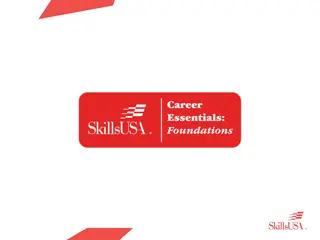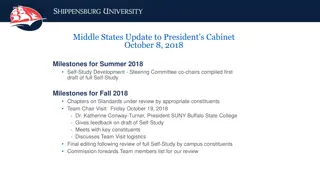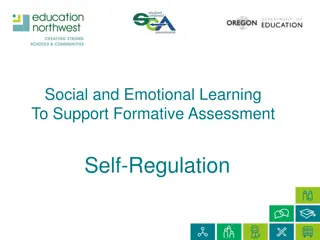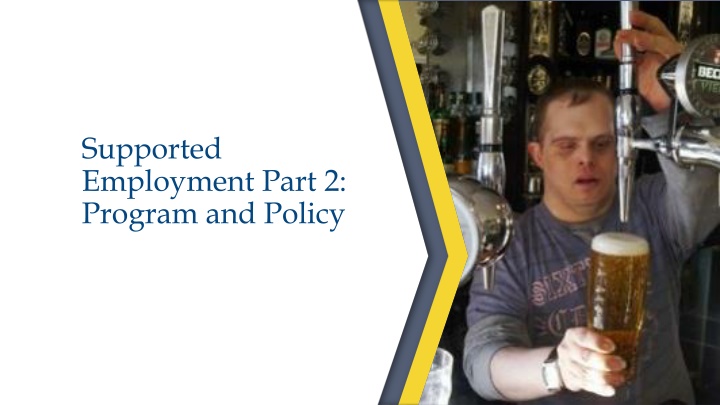
Developing Supported Employment Programs: Key Considerations for State Agencies
Explore key aspects of developing a Supported Employment program for State Vocational Rehabilitation agencies, including service flow, provider considerations, and funding transitions. Learn how to enhance employment outcomes for individuals with disabilities through effective policy and program implementation.
Download Presentation

Please find below an Image/Link to download the presentation.
The content on the website is provided AS IS for your information and personal use only. It may not be sold, licensed, or shared on other websites without obtaining consent from the author. If you encounter any issues during the download, it is possible that the publisher has removed the file from their server.
You are allowed to download the files provided on this website for personal or commercial use, subject to the condition that they are used lawfully. All files are the property of their respective owners.
The content on the website is provided AS IS for your information and personal use only. It may not be sold, licensed, or shared on other websites without obtaining consent from the author.
E N D
Presentation Transcript
Supported Employment Part 2: Program and Policy
Before you start These materials are intended to assist State Vocational Rehabilitation agency leadership in developing or improving their Supported Employment (SE) program. Following a short overview of typical SE service flow, information is presented in the form of questions to consider in these design areas: Case Services Plan Development Contracted Services Financial Tracking The last slide offers quality considerations for SE services and outcomes. A more general overview of Supported Employment is available in Part 1 of this series: Law and Regulations.
Typical SE Service Flow VR gets referral, determines eligibility, develops an IPE that identifies the need for SE services and a provider of extended services VRC and participant identify an appropriate provider of needed services External Community Rehabilitation Program (CRP) Internal VR staff job developer, placement specialist, job coach etc. Referral is made along with authorization for services Job development, job placement, job coaching/training services are provided and billed to the VRC along with progress reports. During this time, the VRC should remain actively involved in the case and oversee the services that are being provided.
Typical SE Service Flow Part 2 Once individual is stably employed, funding for services is transitioned to the extended services funding resource (typically DD or MH)* If the individual is stable on the job for at least 90 days after transitioning to the extended service provider, the VR program may close the case as successfully rehabilitated. *ONE EXCEPTION VR may pay for the extended services for youth with the most significant disabilities for up to 4 years or until the individual turns 25
Going back to appropriate provider of needed services By definition, people who need supported employment services almost always need help finding and getting a job. Who provides that help? Some VR agencies have internal staff that function in the CRP role, providing job development, placement, coaching, and support. These individuals may be called VR Aides, VR Techs, or employment specialists. Most VR agencies contract with CRPs to provide these services. Sometimes CRP staff are co-located at or assigned to a specific VR office and serve only clients of those counselors.
Partnering with CRPs Disadvantages Advantages High turnover and limited qualifications for CRP staff Don t need to hire state employees or pay someone if they re not needed CRP resources may be scarce or nonexistent Allows VRCs to work with large caseloads Communication across team may be more difficult Milestone/outcome systems limit financial risk Limits VR visibility in the business community VR-funded services piggy-back on services paid for by DD/MH
Essential Elements for Supported Employment Program Design - 1 Whether you re starting from scratch or evaluating your existing SE program with an eye toward improvement, there are several areas of design, policy, and procedure that need to be considered. The following slides offer some questions to be considered in the areas of: Case Services Plan Development Contracted Services Financial Tracking
Essential Elements for Supported Employment Program Design: Case Services Who will decide if an applicant needs Supported Employment services? What criteria will be used? Will you have specialized caseloads to deal with SE participants? Will SE services be provided by in-house staff, or by a CRP? What is the role of the VRC if a contractor is being used? Where is this clearly spelled out? How will SE services be recorded in case notes?
Essential Elements for Supported Employment Program Design: Plan Development What needs to be included in the SE Individualized Plan for Employment (IPE)? What are the possible resources for Extended Services (beyond VR)? How will those be identified and documented in the IPE? What are the available resources for information about Medicaid waivers and benefits planning?
Essential Elements for Supported Employment Program Design: Contracted Services If you are contracting with CRPs for SE services, how will you provide comparative information about available CRPs so the client can make an informed choice? On what basis will contracted services be paid? (e.g. fee for service, contract, milestone/outcome, combination) Communications between the service provider and the VRC what kind and how often? What are your options in areas where there are no CRPs; or in situations where there are no CRPs qualified to provide the kind of services needed (e.g. for people with visual or hearing impairments or non-English speakers)? How will contracted services be tracked and evaluated? Who will do this? What are your quality criteria?
Essential Elements for Supported Employment Program Design: Financial Tracking How will you track which expenditures can be paid using SE funds and which will fall under Title 1? How will you forecast and track the 50% of the Federal Supported SE funds that must be used to provide supported employment services (including extended services) to youth with the most significant disabilities?
Supported Self-Employment and Customized Employment While not all individuals seeking self- employment or customized employment require supported employment services, some will need both self-employment with support, or customized employment followed by extended services. The following slides offer questions to consider in developing/implementing these services.
Additional Questions for Supported Self-Employment Some individuals needing supported employment may choose self-employment as their goal. These elements will assist your agency in being ready to support these plans: What resources are available to assist in developing self-employment plans? What criteria will be used to determine whether a self-employment plan is reasonable, and who will make that determination? What needs to be included in the self-employment plan? Who will review it? What are the possible resources for developing a self-employment or business plan? How will self-employment services be tracked and evaluated? What are your quality criteria?
Additional Questions for Customized Employment WIOA specifically includes Customized Employment and Supported Employment services. These elements will assist your agency in implementing CE: Who will decide if an applicant needs Customized Employment services? What resources are available to assist in developing customized employment plans? Who is responsible for coordinating and implementing discovery and planning activities? What needs to be included in the CE plan? Who will review it? How will CE services be tracked and evaluated? What are your quality criteria?
Essential Elements for Supported Employment Program Design - 2 As you think through your plan, don t forget these questions: How will you involve your staff and providers in the development of these policies and procedures? How will you provide training once the plan is in place?
No matter what model of SE or CE is being provided, these are qualities that should be present: And also Consistent with worker s preferences Maximizing work hours and earnings (while honoring preferences) Opportunities to learn meaningful skills and gain advancement Always looking for Hiring by the business (unless self employment) Supervised like other coworkers Paid comparable wage and benefits Integrated Social access to coworkers

